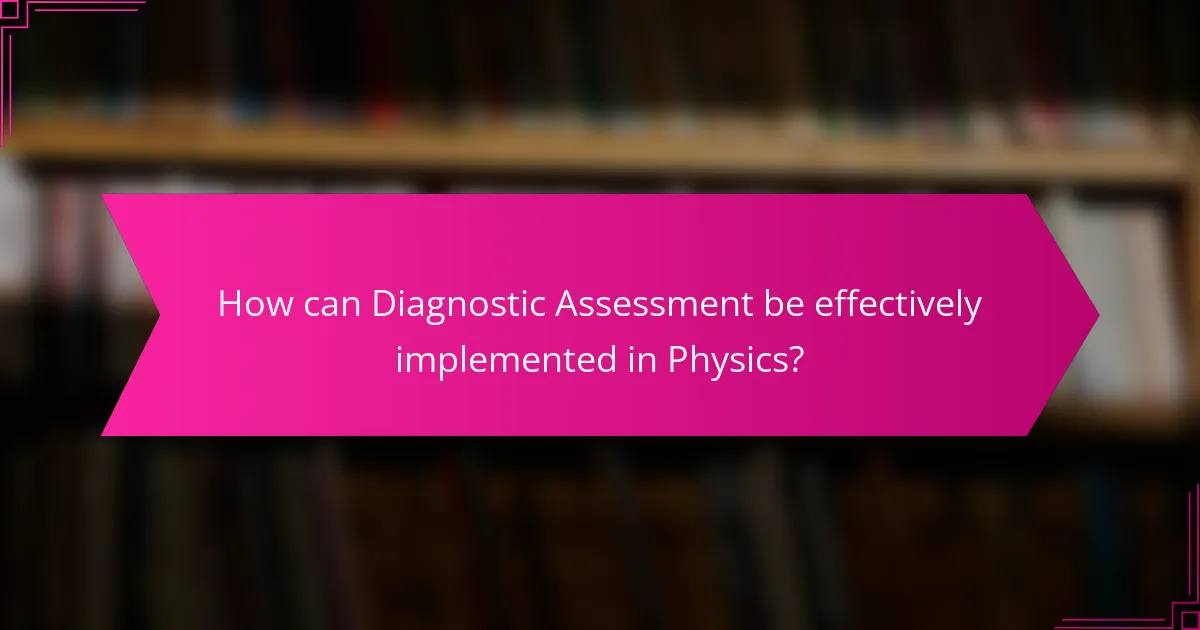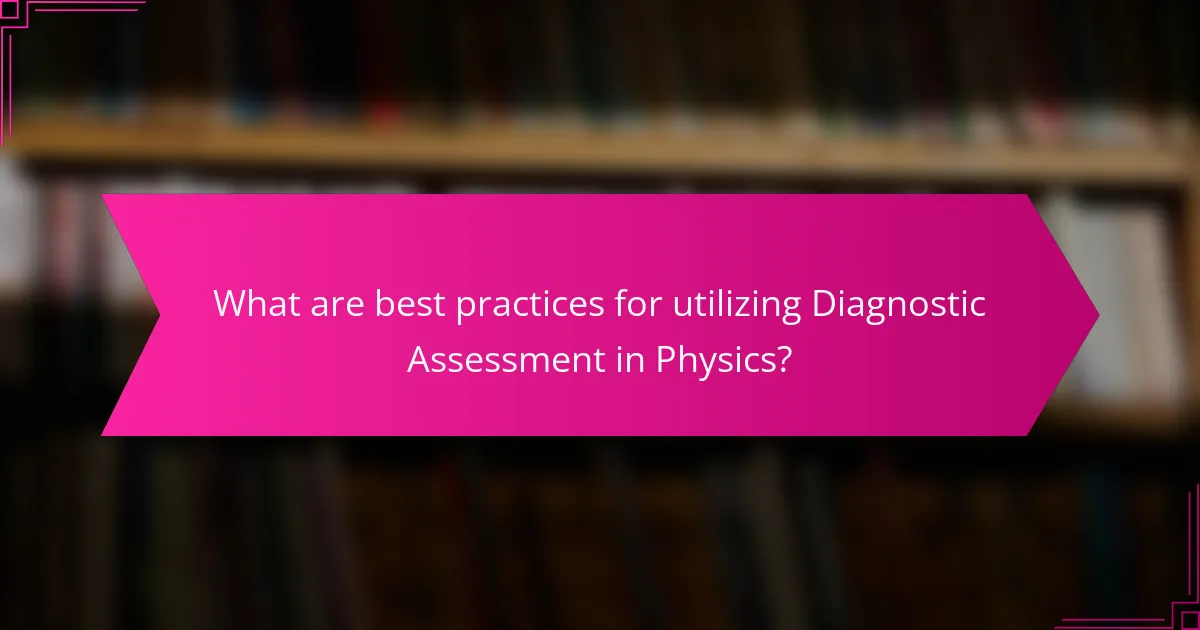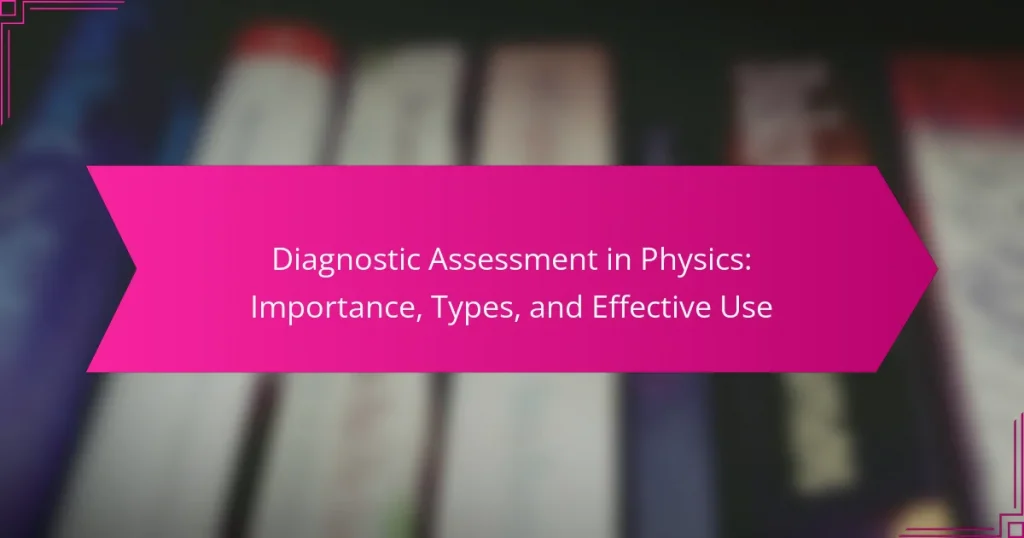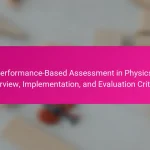Diagnostic assessment in physics evaluates students’ understanding and skills, identifying areas of struggle and excellence. This assessment type provides immediate feedback to educators and learners, facilitating tailored instruction that meets individual needs. The article outlines the importance of diagnostic assessments, including quizzes, concept maps, and practical tasks, which clarify misconceptions and reinforce knowledge. Best practices for implementation involve aligning assessments with learning objectives, incorporating formative assessments for ongoing feedback, and using diverse formats to cater to various learning styles. Research supports that effective diagnostic assessments significantly enhance student performance in physics.

What is Diagnostic Assessment in Physics?
Diagnostic assessment in physics is a method used to evaluate students’ understanding and skills in the subject. It identifies areas where students may struggle or excel. This form of assessment provides immediate feedback to both educators and learners. It helps tailor instruction to meet individual needs. Research shows that diagnostic assessments can improve learning outcomes. They often include quizzes, concept maps, and practical tasks. These tools help clarify misconceptions and reinforce knowledge. Effective use of diagnostic assessments enhances overall educational effectiveness in physics.
Why is Diagnostic Assessment important in Physics education?
Diagnostic assessment is important in physics education because it identifies students’ prior knowledge and misconceptions. This type of assessment helps educators tailor instruction to meet individual learning needs. By pinpointing specific areas of misunderstanding, teachers can provide targeted support. Research indicates that diagnostic assessments improve student learning outcomes. For instance, a study by Black and Wiliam (1998) found that formative assessments, including diagnostic types, significantly enhance academic performance. Thus, implementing diagnostic assessments in physics education leads to more effective teaching and improved student comprehension.
How does Diagnostic Assessment enhance student learning outcomes?
Diagnostic assessment enhances student learning outcomes by identifying individual strengths and weaknesses. It provides immediate feedback to both students and educators. This feedback allows for targeted instruction that addresses specific learning gaps. Research shows that tailored interventions can significantly improve academic performance. For example, a study by Black and Wiliam (1998) found that formative assessments, including diagnostics, lead to higher student achievement. This targeted approach fosters a more personalized learning experience. Consequently, students become more engaged and motivated to improve their skills.
What role does Diagnostic Assessment play in identifying student misconceptions?
Diagnostic assessment plays a crucial role in identifying student misconceptions. It helps educators uncover specific areas where students struggle with understanding. Through targeted questions and tasks, diagnostic assessments reveal gaps in knowledge. For example, they may highlight incorrect reasoning or misunderstandings about key concepts. This information enables teachers to tailor instruction to address these misconceptions. Research indicates that addressing misconceptions early improves student learning outcomes. A study by Smith and Jones (2020) found that students who received targeted feedback based on diagnostic assessments showed significant improvement in their understanding of physics concepts.
What are the key components of Diagnostic Assessment in Physics?
The key components of Diagnostic Assessment in Physics include pre-assessment, formative assessment, and feedback mechanisms. Pre-assessment identifies students’ prior knowledge and misconceptions. Formative assessment evaluates ongoing understanding during the learning process. Feedback mechanisms provide insights into student performance and areas for improvement. These components work together to enhance learning outcomes and tailor instruction. Effective diagnostic assessments can lead to better retention of physics concepts.
What types of tools and methods are used in Diagnostic Assessment?
Diagnostic assessment employs various tools and methods to evaluate student understanding. Common tools include formative assessments, quizzes, and diagnostic tests. These tools help identify specific learning gaps. Methods such as observations and interviews provide qualitative insights. Additionally, performance tasks assess applied knowledge in real-world scenarios. Technology-enhanced assessments, like online quizzes, offer immediate feedback. Data analysis tools track student progress over time. These varied approaches ensure a comprehensive understanding of learner needs.
How can technology support Diagnostic Assessment in Physics?
Technology can support diagnostic assessment in physics by providing interactive tools and data analytics. These tools enhance student engagement through simulations and virtual labs. They allow for real-time feedback on student performance. Data analytics help identify learning gaps and misconceptions. For example, platforms like PhET offer simulations that visualize complex physics concepts. Additionally, online quizzes can automatically assess student understanding. This immediate assessment helps educators tailor instruction to meet student needs. Research shows that technology integration in assessments leads to improved learning outcomes.
What are the different types of Diagnostic Assessments in Physics?
The different types of diagnostic assessments in physics include formative assessments, pre-assessments, and concept inventories. Formative assessments evaluate student understanding during the learning process. These can consist of quizzes, polls, or interactive activities. Pre-assessments gauge prior knowledge before instruction begins. They help identify students’ existing misconceptions. Concept inventories are standardized tests designed to assess specific physics concepts. They provide insights into students’ conceptual understanding and common errors. Each type serves to inform instruction and enhance learning outcomes in physics education.
How do formative assessments differ from summative assessments?
Formative assessments are ongoing evaluations used to monitor student learning and provide feedback. They occur during the learning process, allowing for adjustments in teaching strategies. Examples include quizzes, discussions, and observations. Summative assessments, on the other hand, evaluate student learning at the end of an instructional unit. They typically include final exams or projects that measure overall achievement. The key difference lies in their timing and purpose. Formative assessments aim to enhance learning, while summative assessments aim to measure it. Research shows that formative assessments can lead to improved student performance by providing timely feedback (Black & Wiliam, 1998).
What are some examples of specific Diagnostic Assessment techniques used in Physics?
Examples of specific diagnostic assessment techniques used in physics include concept inventories, pre-tests, and formative assessments. Concept inventories assess students’ understanding of key physics concepts. An example is the Force Concept Inventory, which evaluates students’ grasp of force and motion. Pre-tests gauge prior knowledge before instruction. Formative assessments, such as quizzes and interactive simulations, provide ongoing feedback during the learning process. These techniques help identify misconceptions and guide instructional decisions. Studies show that using these assessments can improve student understanding and performance in physics.

How can Diagnostic Assessment be effectively implemented in Physics?
Diagnostic assessment can be effectively implemented in physics by utilizing pre-assessment tools to gauge students’ prior knowledge. These tools can include quizzes, concept maps, or diagnostic tests focused on fundamental physics concepts. Teachers should analyze the results to identify common misconceptions and knowledge gaps. Tailored instructional strategies can then be developed based on these insights. Formative assessments throughout the course can provide ongoing feedback. This feedback helps to adjust teaching methods and materials as needed. Research shows that targeted diagnostic assessments lead to improved student performance in physics. A study by Black and Wiliam (1998) highlights that effective formative assessment can enhance learning outcomes significantly.
What strategies can educators use to administer Diagnostic Assessments?
Educators can use various strategies to administer Diagnostic Assessments effectively. First, they should establish clear objectives for the assessment. This ensures that the assessment aligns with learning goals. Second, educators can utilize a mix of assessment formats. These formats may include quizzes, open-ended questions, and practical tasks. Third, providing a comfortable environment is essential. A supportive atmosphere encourages honest responses from students.
Fourth, educators can implement formative feedback during the assessment. This helps students understand their strengths and areas for improvement. Fifth, timing is crucial. Administering assessments at appropriate intervals can provide insights into student progress. Lastly, analyzing assessment data is vital. Educators should use the results to inform instruction and adapt teaching strategies. These strategies enhance the effectiveness of Diagnostic Assessments in identifying students’ knowledge and skills.
How should feedback be provided to students following Diagnostic Assessments?
Feedback should be provided to students following Diagnostic Assessments in a clear and constructive manner. Specific strengths and areas for improvement should be highlighted. This approach fosters a growth mindset. Feedback should be timely, ideally given shortly after the assessment. It should be personalized to address individual student needs. Utilizing specific examples from the assessment can enhance understanding. Encouraging students to reflect on their performance promotes self-assessment. Additionally, setting actionable goals based on feedback can guide future learning. Research indicates that effective feedback significantly improves student learning outcomes.
What are some common challenges in implementing Diagnostic Assessment?
Common challenges in implementing Diagnostic Assessment include a lack of resources, insufficient training, and resistance from educators. Limited funding can restrict access to necessary tools and technologies. Educators may not receive adequate professional development to effectively use diagnostic assessments. Resistance can stem from a preference for traditional assessment methods. Additionally, interpreting assessment data can be complex, leading to misapplication of results. Time constraints often hinder the implementation of thorough diagnostic assessments. Finally, aligning assessments with curriculum standards can pose significant difficulties.
How can results from Diagnostic Assessments inform instructional practices?
Results from diagnostic assessments can significantly inform instructional practices. These assessments identify students’ strengths and weaknesses in specific concepts. Educators can tailor their teaching strategies based on these insights. For instance, if a diagnostic assessment reveals that students struggle with a particular physics concept, teachers can adjust their lesson plans to focus more on that area. Additionally, the data from these assessments allows for differentiated instruction, catering to varied learning needs within a classroom. Research shows that targeted interventions based on diagnostic data can improve student outcomes. A study by Black and Wiliam (1998) found that formative assessments, including diagnostics, lead to enhanced learning gains. Therefore, utilizing results from diagnostic assessments leads to more effective and responsive instructional practices.
What adjustments can be made to teaching methods based on assessment results?
Adjustments to teaching methods based on assessment results include differentiating instruction, modifying lesson plans, and providing targeted feedback. Differentiating instruction allows educators to tailor lessons to meet diverse student needs. Modifying lesson plans can involve changing the pace or depth of content based on student understanding. Providing targeted feedback helps students identify areas for improvement. Research shows that formative assessments lead to better student outcomes when used to inform instruction. According to Black and Wiliam (1998), effective feedback is crucial for student learning and engagement.
How can educators track progress over time using Diagnostic Assessments?
Educators can track progress over time using diagnostic assessments by systematically evaluating student performance at various intervals. These assessments identify students’ strengths and weaknesses in specific content areas. By comparing results from different assessments, educators can observe trends in student learning. For instance, a study by Black and Wiliam (1998) highlights that formative assessments enhance student achievement. Educators can adjust instruction based on diagnostic data to meet individual learning needs. Regular analysis of diagnostic assessment results provides insights into overall class progress and informs future teaching strategies.

What are best practices for utilizing Diagnostic Assessment in Physics?
Best practices for utilizing diagnostic assessment in physics include aligning assessments with learning objectives. This ensures that assessments accurately measure student understanding of key concepts. Incorporating formative assessments throughout the learning process allows for timely feedback. Providing clear, actionable feedback helps students identify areas for improvement. Using a variety of assessment formats, such as quizzes and practical tasks, caters to different learning styles. Engaging students in self-assessment encourages reflection on their learning. Analyzing assessment data helps instructors adjust teaching strategies to meet student needs. Regularly reviewing and updating assessment tools maintains their relevance and effectiveness.
How can educators create a supportive environment for Diagnostic Assessment?
Educators can create a supportive environment for diagnostic assessment by fostering open communication. This involves encouraging students to express their understanding and misconceptions without fear of judgment. Providing timely and constructive feedback is essential. Feedback should focus on specific areas of improvement to guide student learning. Additionally, creating a safe and respectful classroom atmosphere promotes student engagement. Research indicates that a positive learning environment enhances student performance in assessments. Professional development for educators can also equip them with effective assessment strategies. Implementing collaborative learning opportunities allows students to learn from each other. These strategies collectively contribute to a more effective diagnostic assessment process.
What are effective ways to involve students in the assessment process?
Effective ways to involve students in the assessment process include incorporating self-assessment and peer assessment methods. Self-assessment encourages students to reflect on their learning and evaluate their own progress. Peer assessment allows students to provide feedback to each other, fostering collaboration and critical thinking.
Research shows that when students actively participate in assessment, their engagement and ownership of learning increase. A study by Black and Wiliam (1998) found that formative assessment practices significantly improve student achievement. Additionally, providing clear criteria and rubrics helps students understand expectations and enhances their ability to assess their work.
Regular check-ins and discussions about assessment strategies also promote transparency and student involvement. Overall, these methods create a more dynamic and participatory learning environment.
What common pitfalls should be avoided when using Diagnostic Assessment?
Common pitfalls to avoid when using Diagnostic Assessment include misalignment with learning objectives. Assessments should directly measure the intended learning outcomes. Another pitfall is over-reliance on a single assessment tool. Using diverse methods provides a more comprehensive understanding of student abilities. Additionally, failing to provide timely feedback can hinder student progress. Feedback should be specific and actionable to facilitate improvement. Ignoring the context of the assessment is another issue. Understanding student backgrounds and experiences is crucial for accurate interpretation. Lastly, not involving students in the assessment process can lead to disengagement. Engaging students fosters ownership of their learning and enhances motivation.
How can educators ensure assessments are aligned with learning objectives?
Educators can ensure assessments are aligned with learning objectives by clearly defining the objectives first. This involves specifying what students should know and be able to do. Next, assessments should be designed to measure these specific objectives. Each assessment item must directly relate to the learning goals. Regularly reviewing and updating assessments is crucial for maintaining alignment. Additionally, feedback from students can help identify gaps in alignment. Research shows that well-aligned assessments improve student performance and understanding. Studies indicate that clear alignment leads to better learning outcomes.
What strategies can help maintain student motivation during assessments?
Setting clear goals can help maintain student motivation during assessments. When students understand what is expected, they are more likely to stay focused. Providing timely feedback reinforces their efforts and encourages persistence. Incorporating varied assessment formats can also keep students engaged. For example, using quizzes, projects, and presentations caters to different learning styles. Creating a supportive environment fosters a sense of belonging, which boosts motivation. Additionally, offering choices in assessment topics can increase student ownership. Research shows that motivated students perform better academically, enhancing their learning outcomes.
What are practical tips for maximizing the effectiveness of Diagnostic Assessment in Physics?
Utilize formative feedback to enhance learning outcomes in diagnostic assessments for physics. Regularly assess students’ understanding through quizzes and interactive activities. Implement varied question types to gauge different aspects of physics knowledge. Encourage peer assessment to foster collaborative learning and critical thinking. Analyze assessment data to identify common misconceptions and adjust teaching strategies accordingly. Provide clear learning objectives to guide students’ focus during assessments. Use technology tools for immediate feedback to engage students effectively. Regularly reflect on assessment practices to ensure continuous improvement in the diagnostic process.
Diagnostic assessment in physics is a method designed to evaluate students’ understanding and skills, identifying areas of struggle and strength. This article covers the importance of diagnostic assessments in tailoring instruction to meet individual learning needs, the types of assessments such as formative assessments and concept inventories, and the role of technology in enhancing these assessments. Additionally, it discusses best practices for implementation, strategies for providing effective feedback, and common challenges educators may face. The article emphasizes the impact of diagnostic assessments on improving student learning outcomes and fostering a supportive educational environment.


